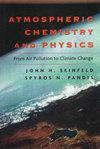气溶胶-气象反馈减少了黑碳向青藏高原的越境迁移
IF 5.1
1区 地球科学
Q1 ENVIRONMENTAL SCIENCES
引用次数: 0
摘要
摘要黑碳(BC)对气候具有潜在影响,尤其是在青藏高原(TP),那里的冰冻圈和环境对气候变化非常敏感。2016 年 4 月 20 日至 5 月 10 日期间,青藏高原出现了破纪录的气溶胶污染事件。本文利用观测和再分析数据集,以及基于气象和气溶胶/化学耦合模式(WRF-Chem)的模拟,研究了严重气溶胶污染事件的气象成因、BC 跨界传输通量、气溶胶-气象反馈及其对严重气溶胶污染事件期间BC 跨界传输通量的影响。通过分析再分析数据集得出的天气图,发现高原涡旋和偏南风是造成严重气溶胶污染事件的关键因素。随后,由于 WRF-Chem 模型在气象条件和气溶胶时空特征方面的良好性能,研究了污染事件期间 BC 的越境传输通量。结果表明,BC 的垂直综合跨喜马拉雅迁移通量自西向东递减,最大迁移通量为 20.8 mg m-2 s-1,出现在大西南最深的山谷。有气溶胶气象反馈和无气溶胶气象反馈的模拟结果表明,气溶胶导致南部大洋洲和印度-甘肃平原(IGP)的气象条件发生显著变化,两个地区的大气分层更加稳定,行星边界层高度降低,南部大洋洲的 10 米风速增加,而印度-甘肃平原的 10 米风速降低。气象条件的变化反过来又导致南部热量区的地表 BC 浓度下降达 0.16 µg m-3 (50%),而 IGP 的地表 BC 浓度上升达 2.2 µg m-3 (75%)。此外,研究还发现气溶胶-气象反馈降低了从喜马拉雅山中部和西部向大倾角地区的垂直综合越境迁移通量。这项研究不仅为减轻气溶胶在大洋洲大陆上空造成的冰川融化提供了重要的政策影响,而且对保护大洋洲大陆的生态环境也具有重要意义。本文章由计算机程序翻译,如有差异,请以英文原文为准。
Aerosol–meteorology feedback diminishes the transboundary transport of black carbon into the Tibetan Plateau
Abstract. Black carbon (BC) exerts potential effects on climate, especially in the Tibetan Plateau (TP), where the cryosphere and environment are very sensitive to climate change. The TP saw a record-breaking aerosol pollution event during the period from 20 April to 10 May 2016. This paper investigates the meteorological causes of the severe aerosol pollution event, the transboundary transport flux of BC, the aerosol–meteorology feedback, and its effect on the transboundary transport flux of BC during the severe aerosol pollution event using observational and reanalysis datasets as well as simulation based on a coupled meteorology and aerosol/chemistry model, Weather Research and Forecasting model coupled with Chemistry (WRF-Chem). By analyzing weather maps derived from the reanalysis dataset, it is found that the plateau vortex and southerly winds were key factors that contributed to the severe aerosol pollution event. Subsequently, due to the good performance of the WRF-Chem model for the spatiotemporal characteristics of meteorological conditions and aerosols, the transboundary transport flux of BC during the pollution event was investigated. The results show that the vertically integrated cross-Himalayan transport flux of BC decreases from west to east, with the largest transport flux of 20.8 mg m−2 s−1 occurring at the deepest mountain valley in southwestern TP. Results from simulations with and without aerosol–meteorology feedback show that aerosols induce significant changes in meteorological conditions in the southern TP and the Indo-Gangetic Plain (IGP), with the atmospheric stratification being more stable and the planetary boundary layer height decreasing in both regions, and the 10 m wind speed increasing in the southern TP but decreasing in the IGP. Changes in meteorological conditions in turn lead to a decrease in the surface BC concentration in the southern TP of up to 0.16 µg m−3 (50 %) and an increase in the surface BC concentration in the IGP of up to 2.2 µg m−3 (75 %). In addition, it is found that the aerosol–meteorology feedback decreases the vertically integrated transboundary transport flux of BC from the central and western Himalayas towards the TP. This study not only provides crucial policy implications for mitigating glacier melt caused by aerosols over the TP but is also of great significance for the protection of the ecological environment of the TP.
求助全文
通过发布文献求助,成功后即可免费获取论文全文。
去求助
来源期刊

Atmospheric Chemistry and Physics
地学-气象与大气科学
CiteScore
10.70
自引率
20.60%
发文量
702
审稿时长
6 months
期刊介绍:
Atmospheric Chemistry and Physics (ACP) is a not-for-profit international scientific journal dedicated to the publication and public discussion of high-quality studies investigating the Earth''s atmosphere and the underlying chemical and physical processes. It covers the altitude range from the land and ocean surface up to the turbopause, including the troposphere, stratosphere, and mesosphere.
The main subject areas comprise atmospheric modelling, field measurements, remote sensing, and laboratory studies of gases, aerosols, clouds and precipitation, isotopes, radiation, dynamics, biosphere interactions, and hydrosphere interactions. The journal scope is focused on studies with general implications for atmospheric science rather than investigations that are primarily of local or technical interest.
 求助内容:
求助内容: 应助结果提醒方式:
应助结果提醒方式:


